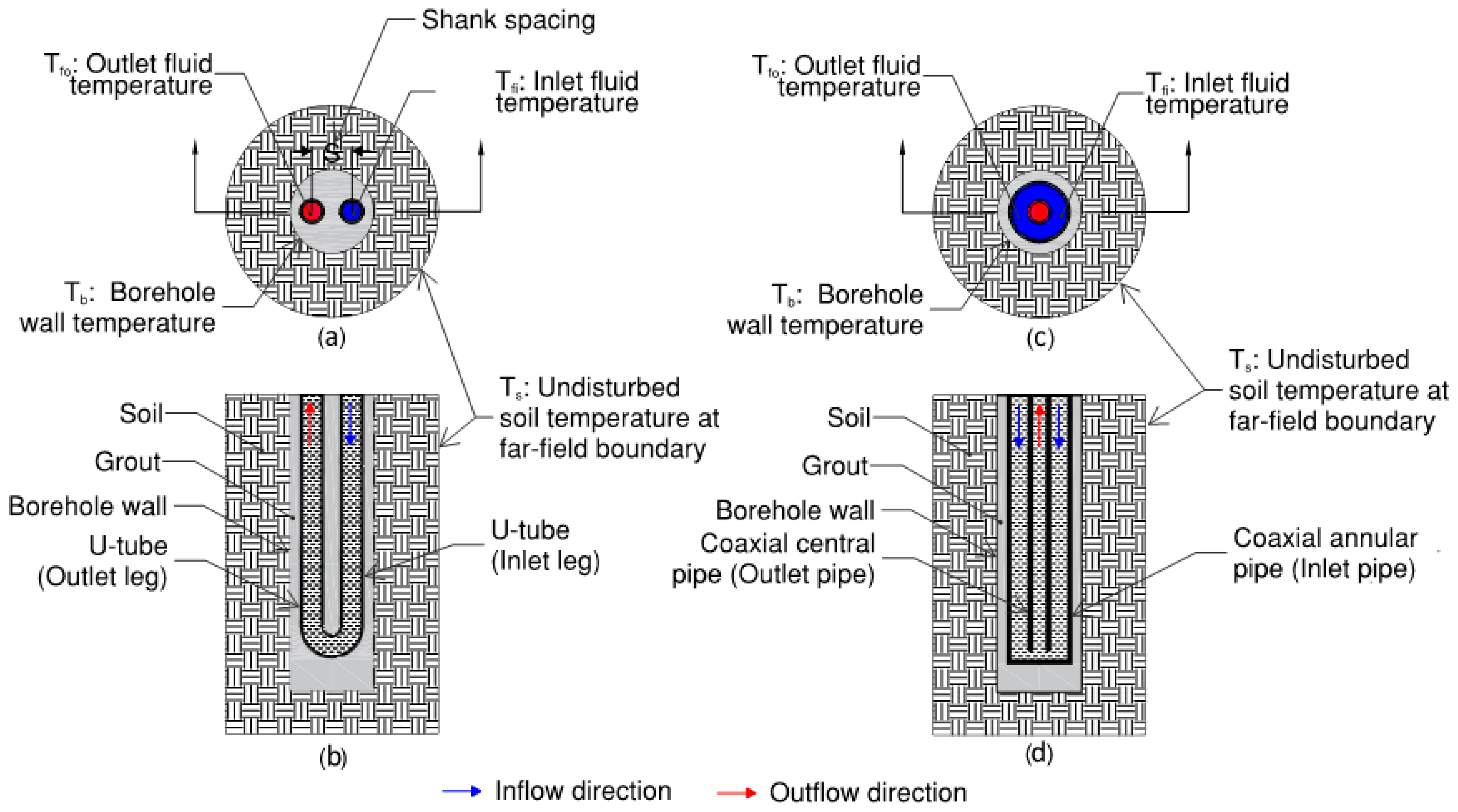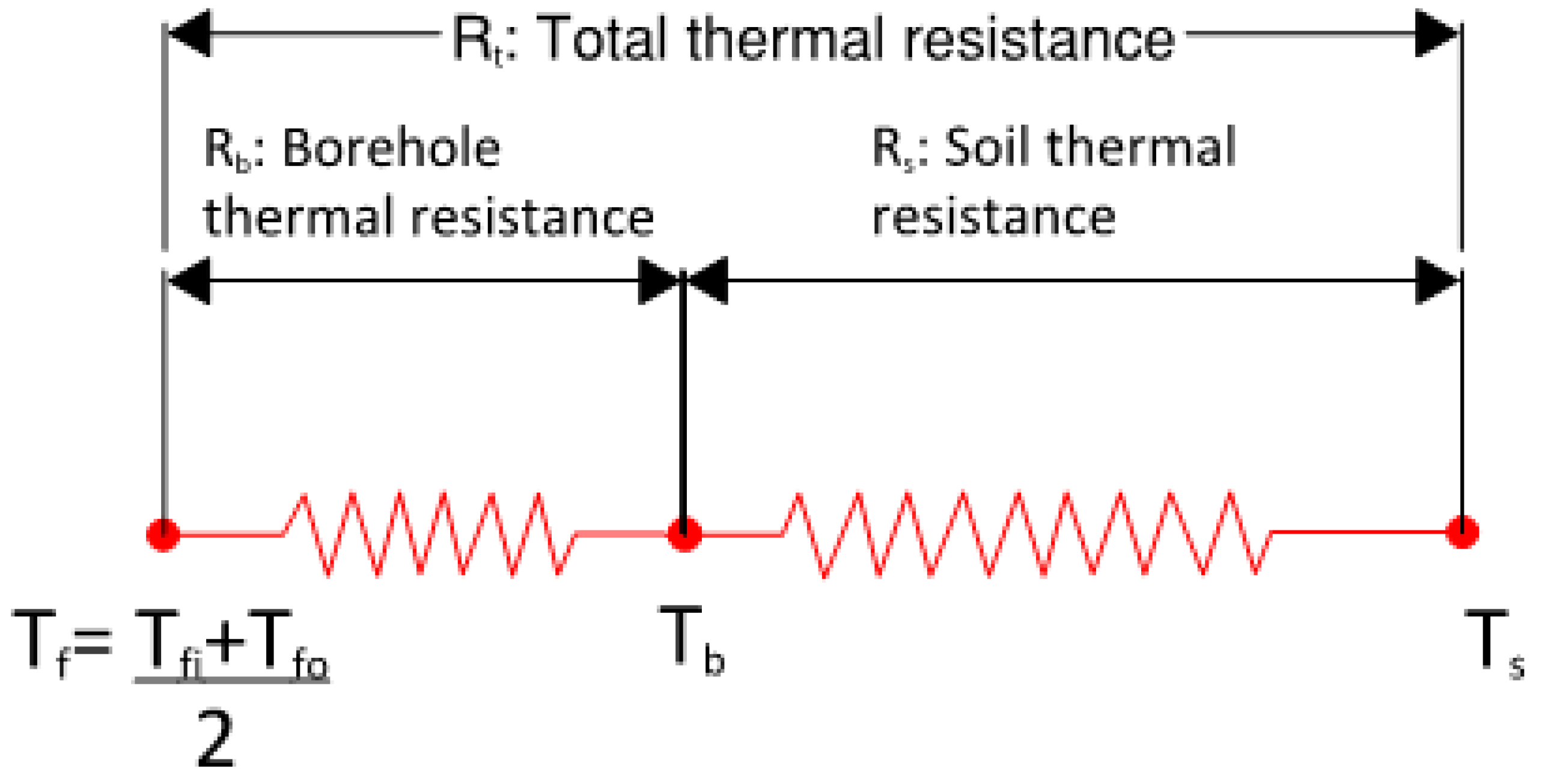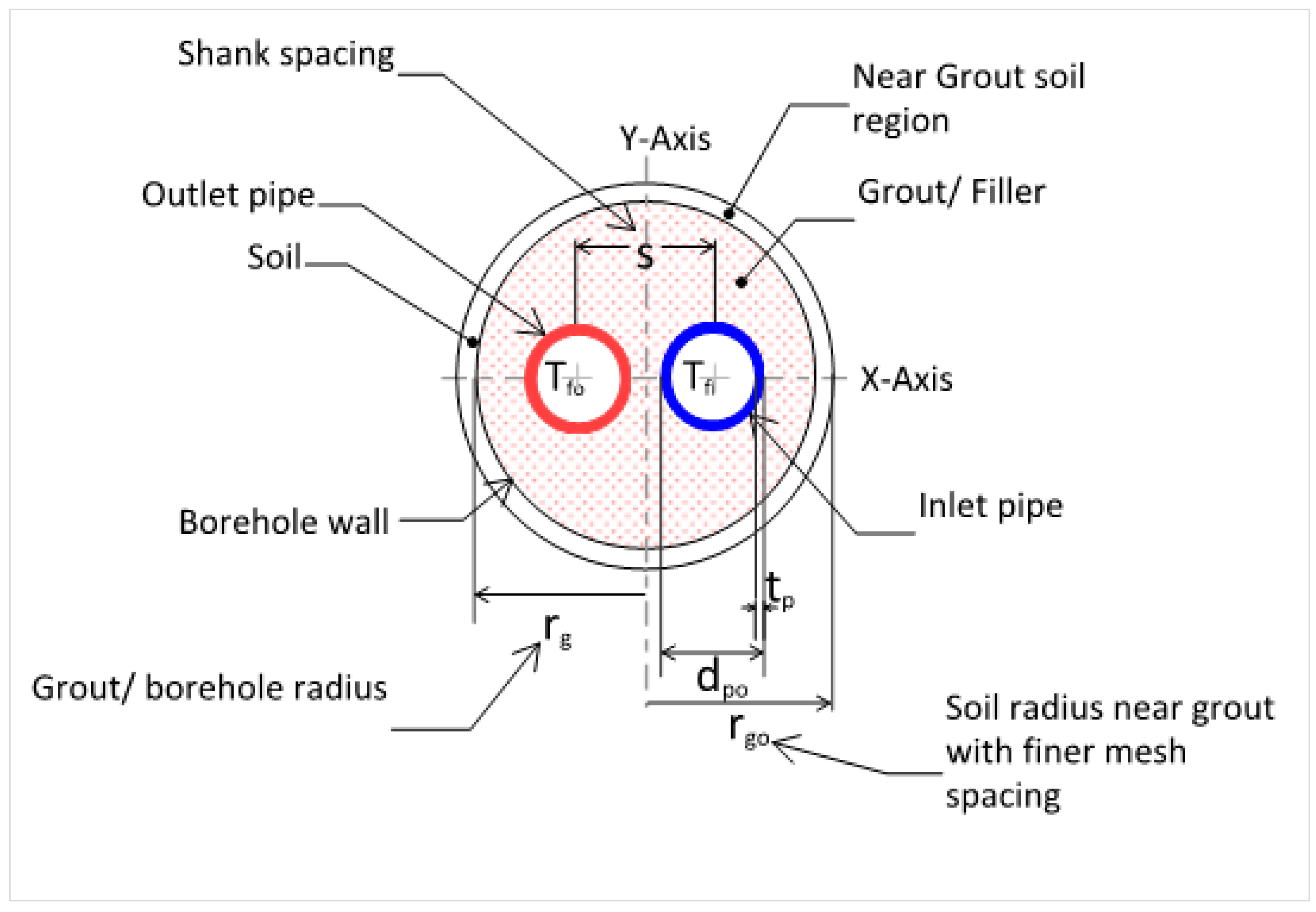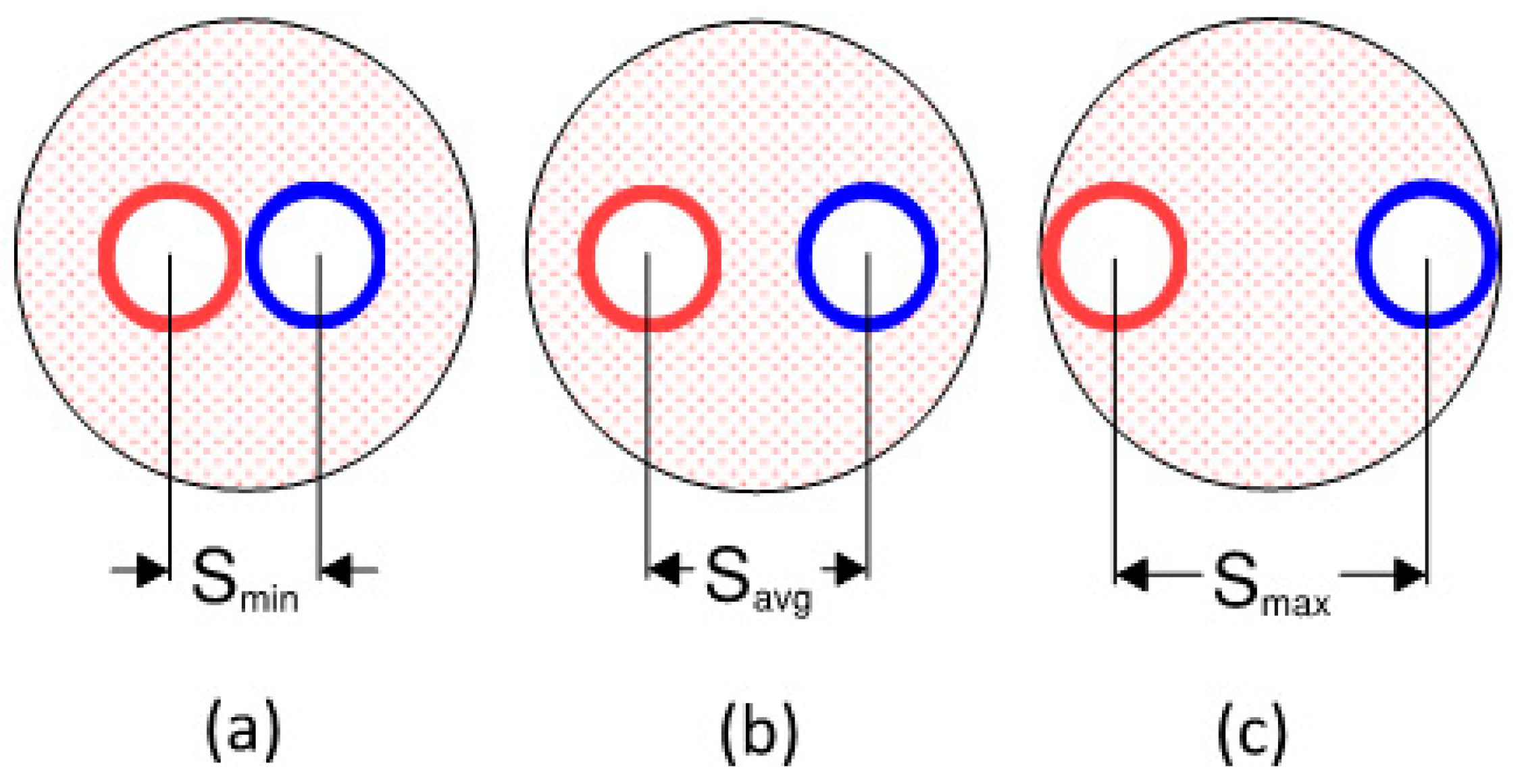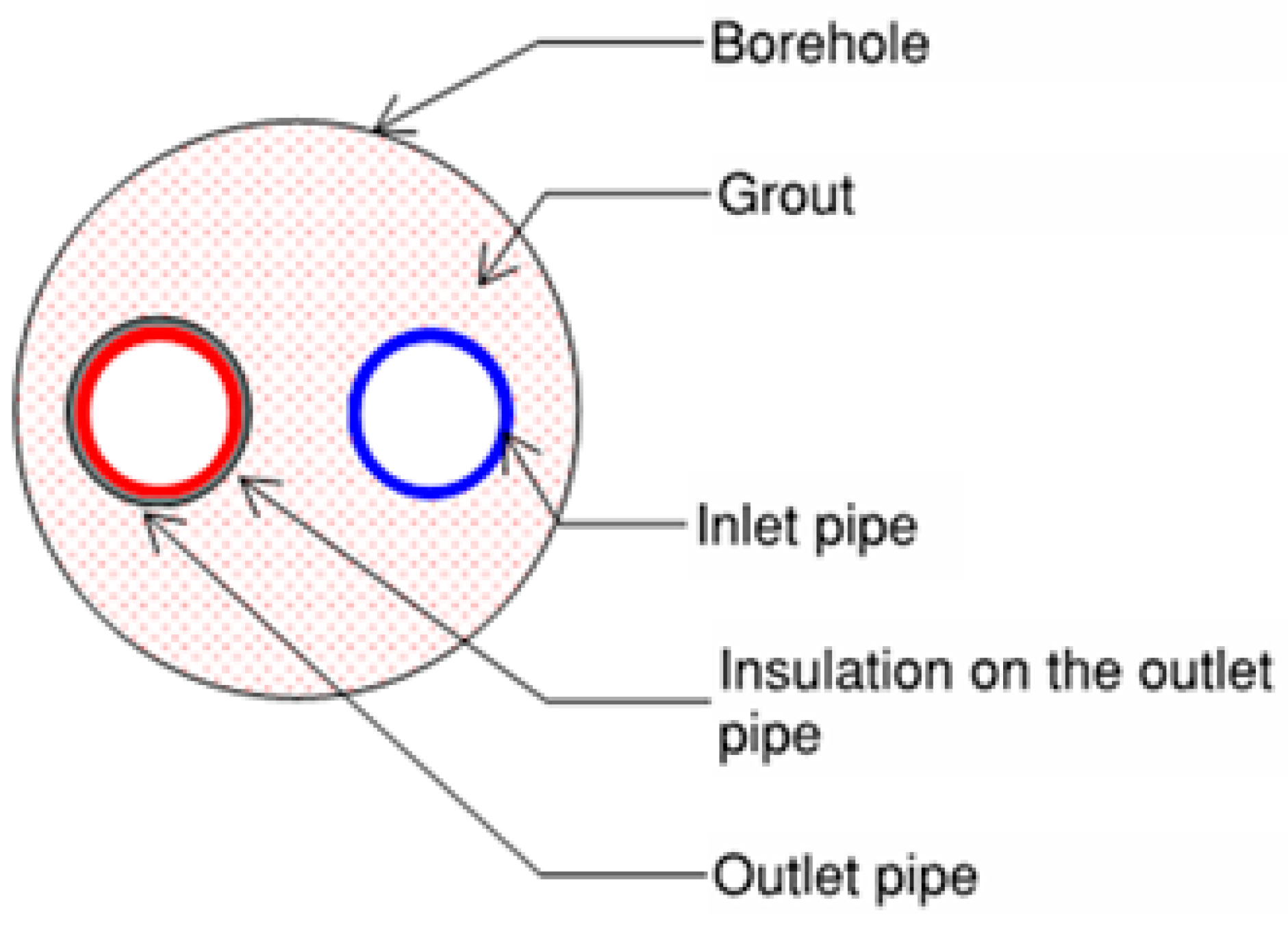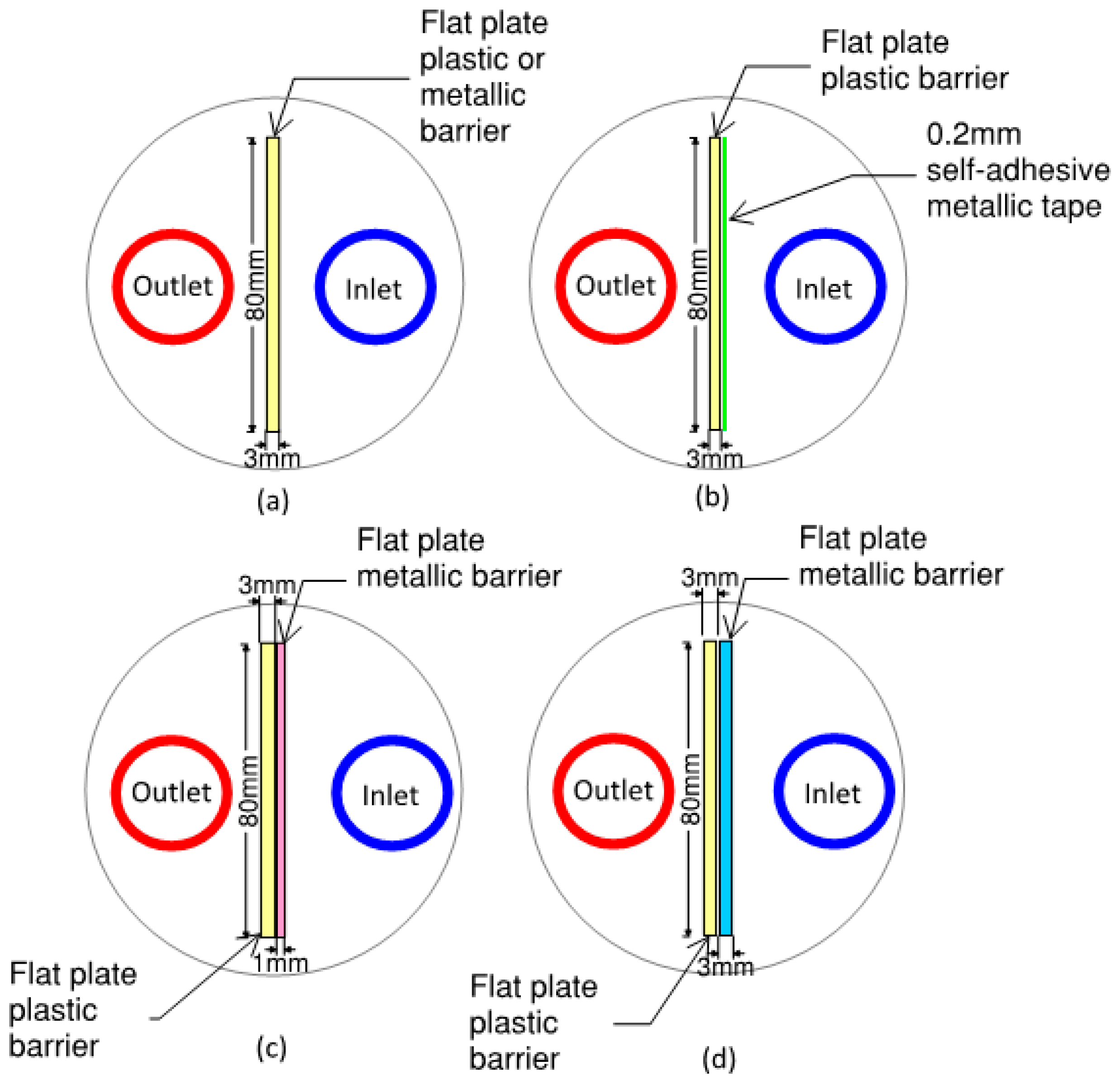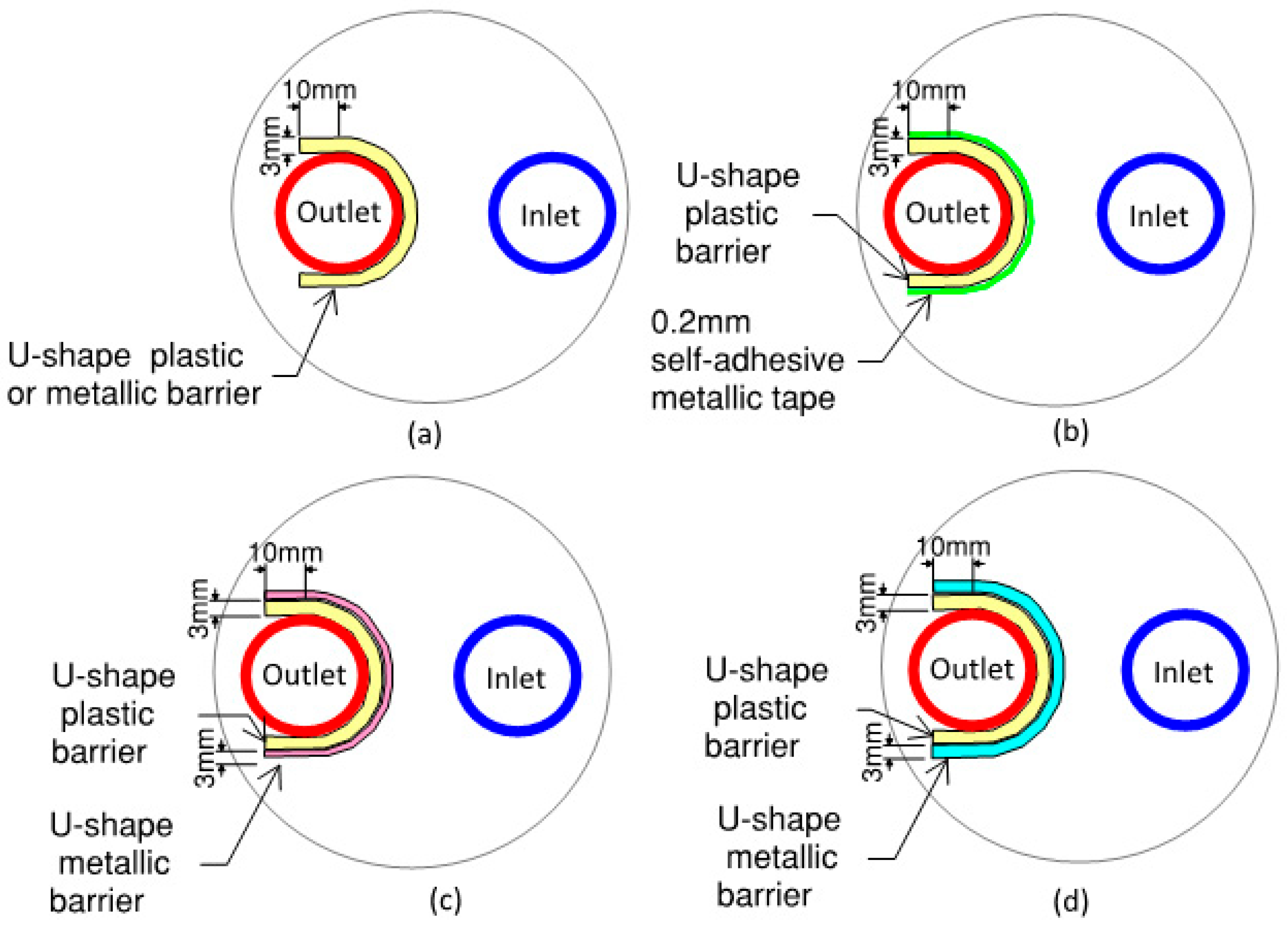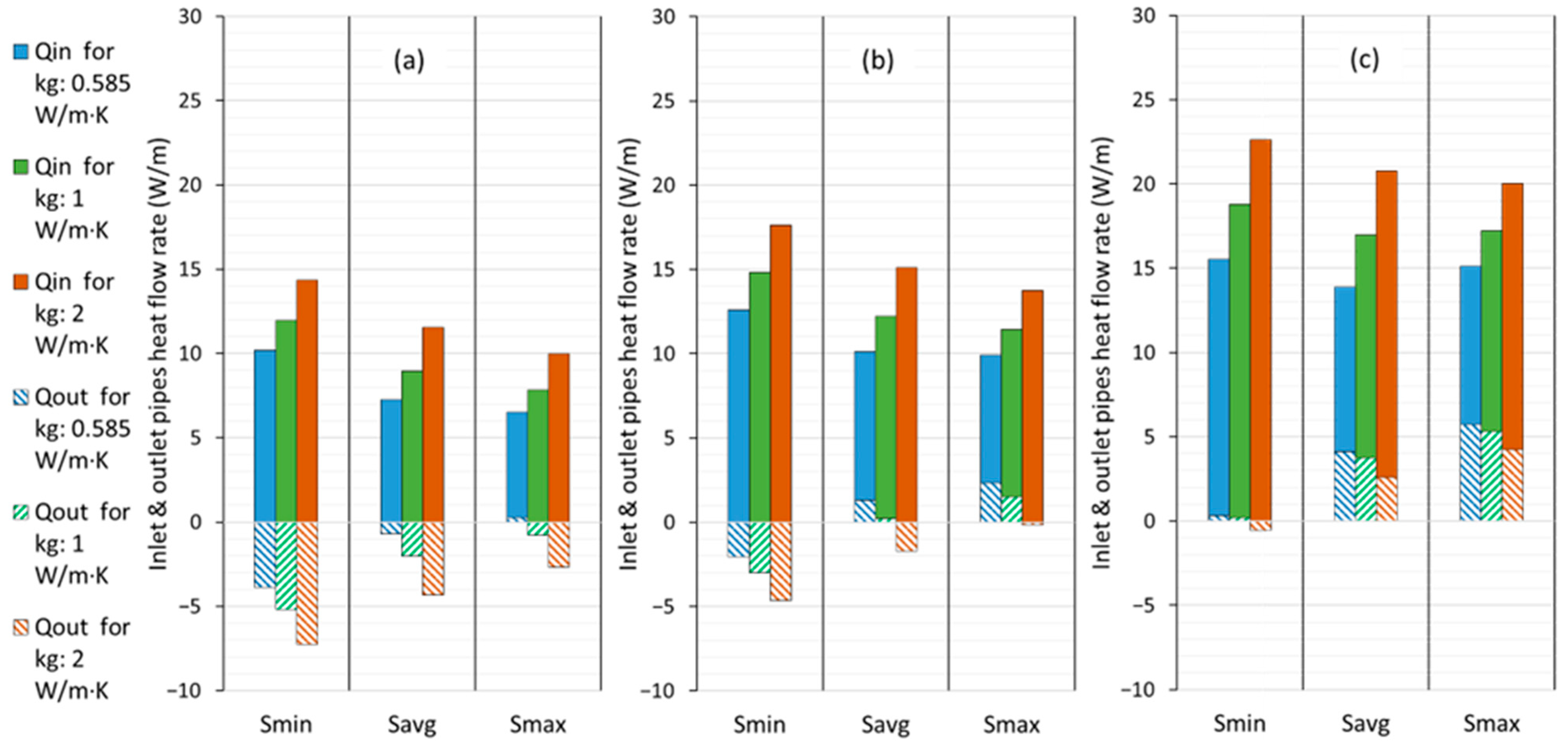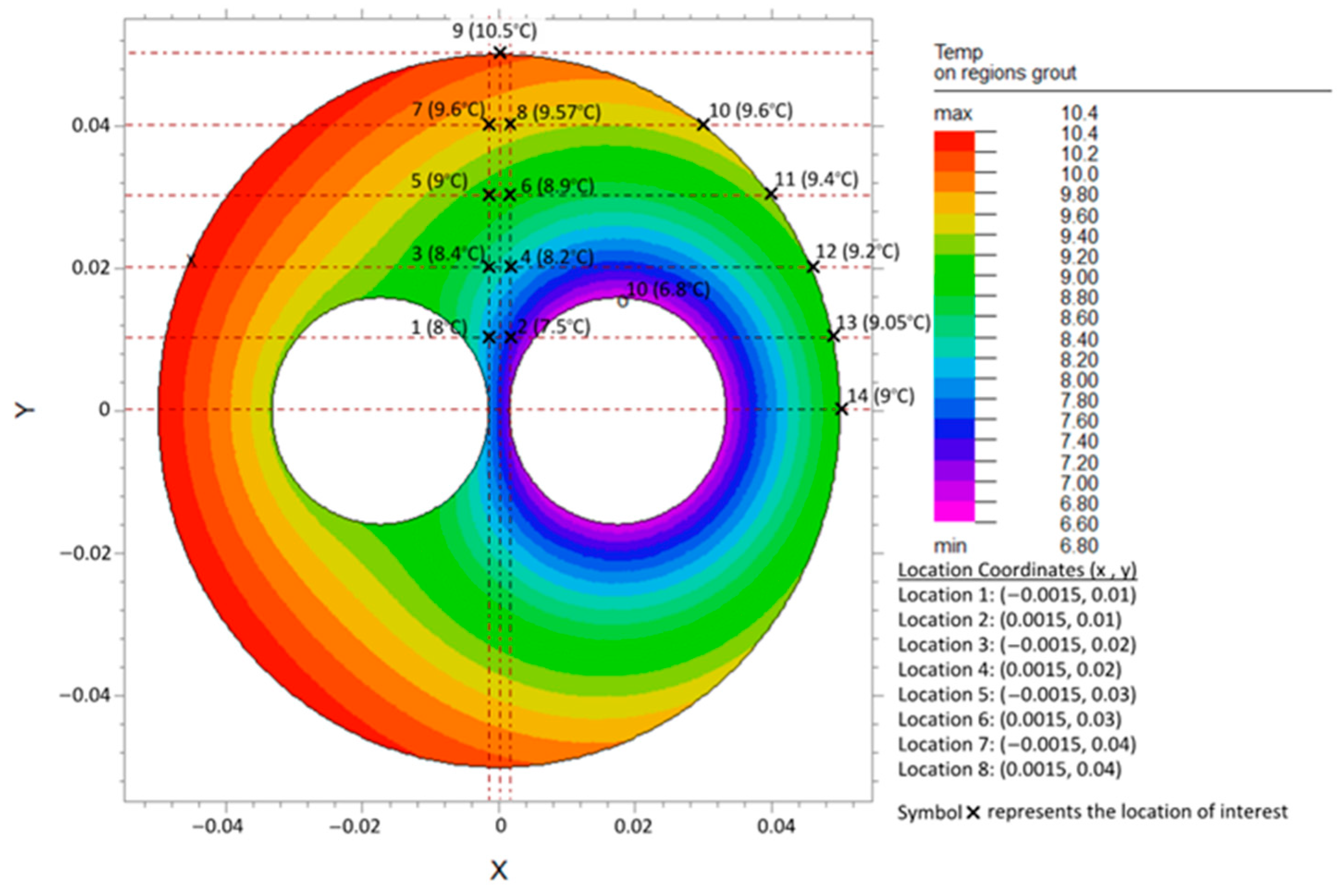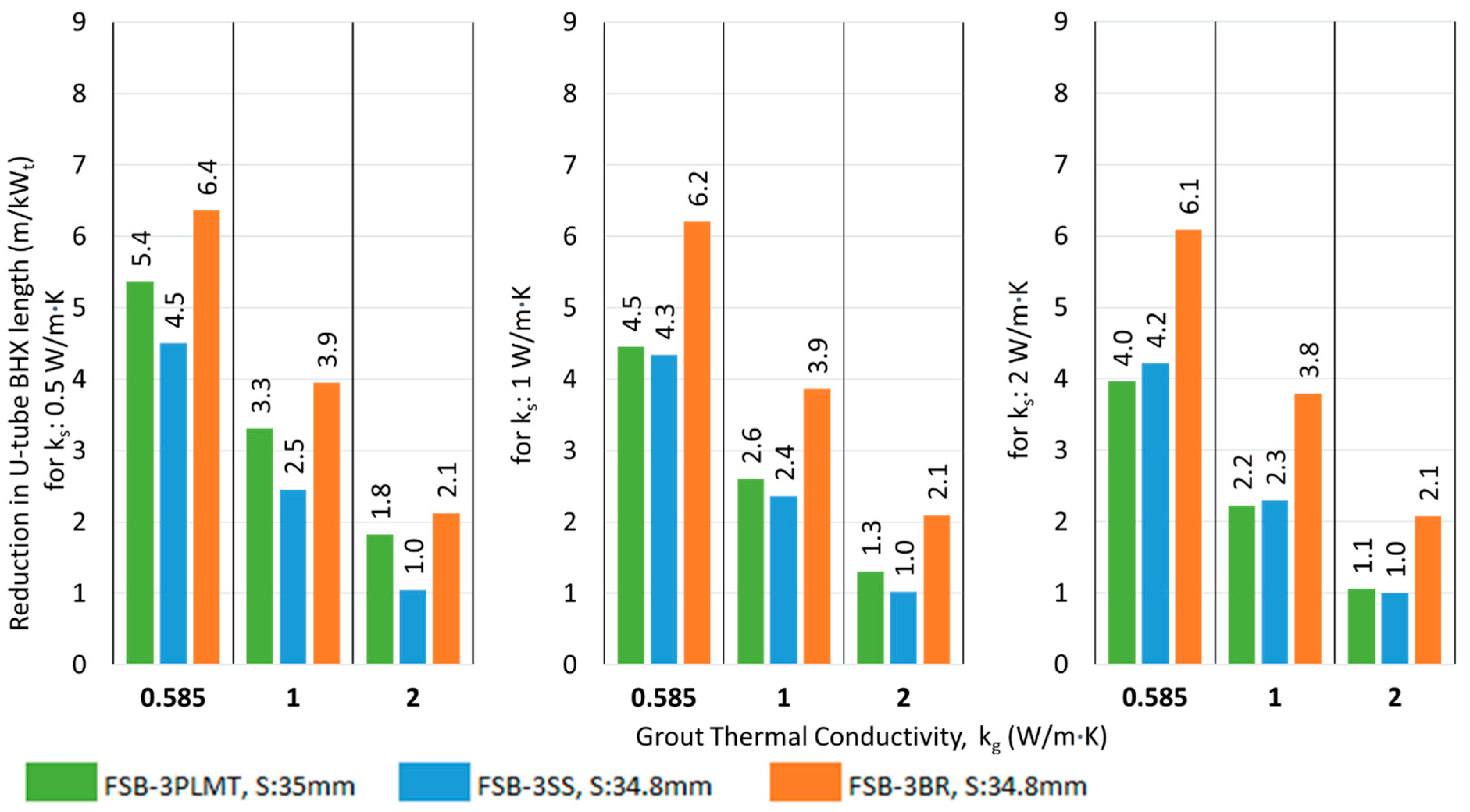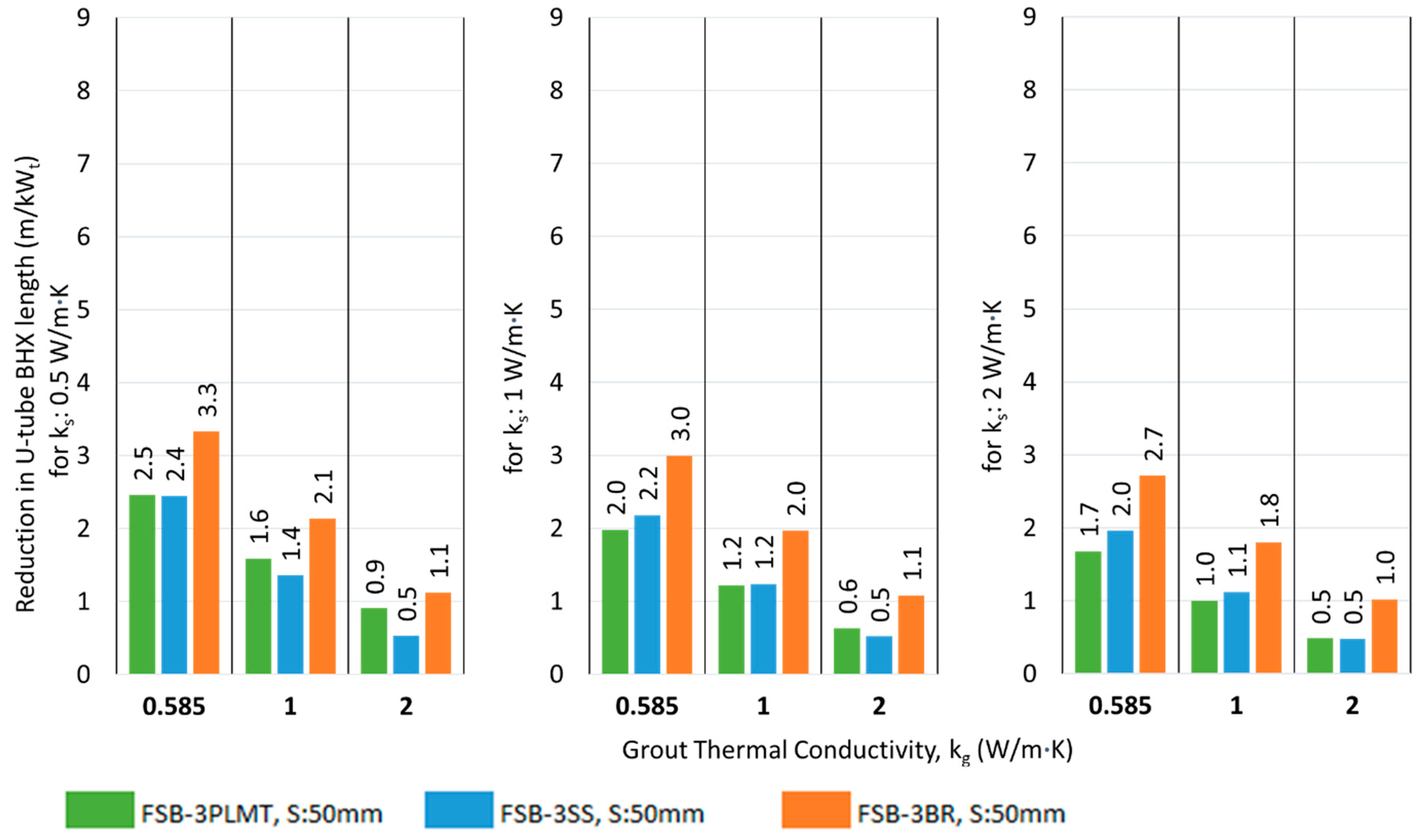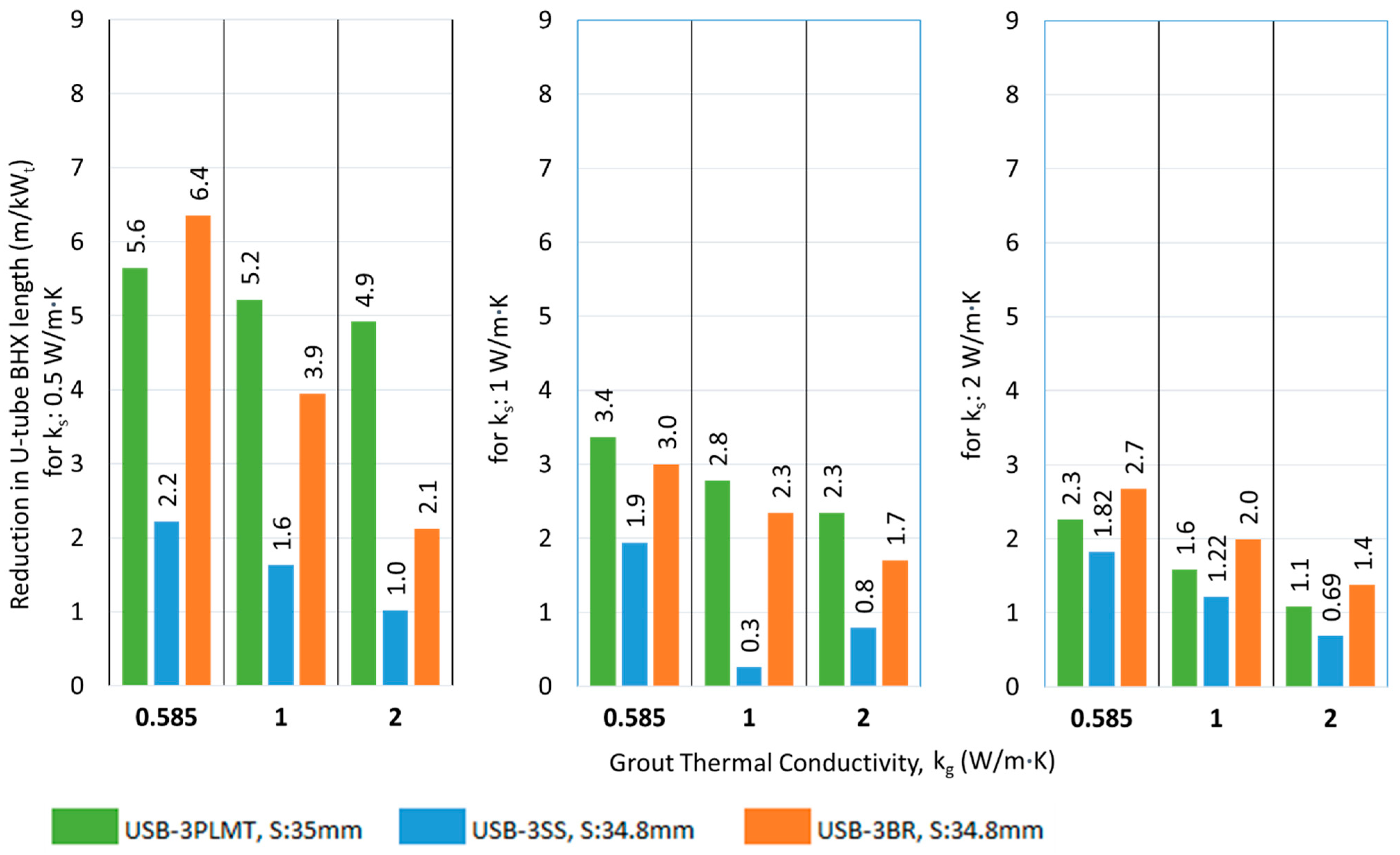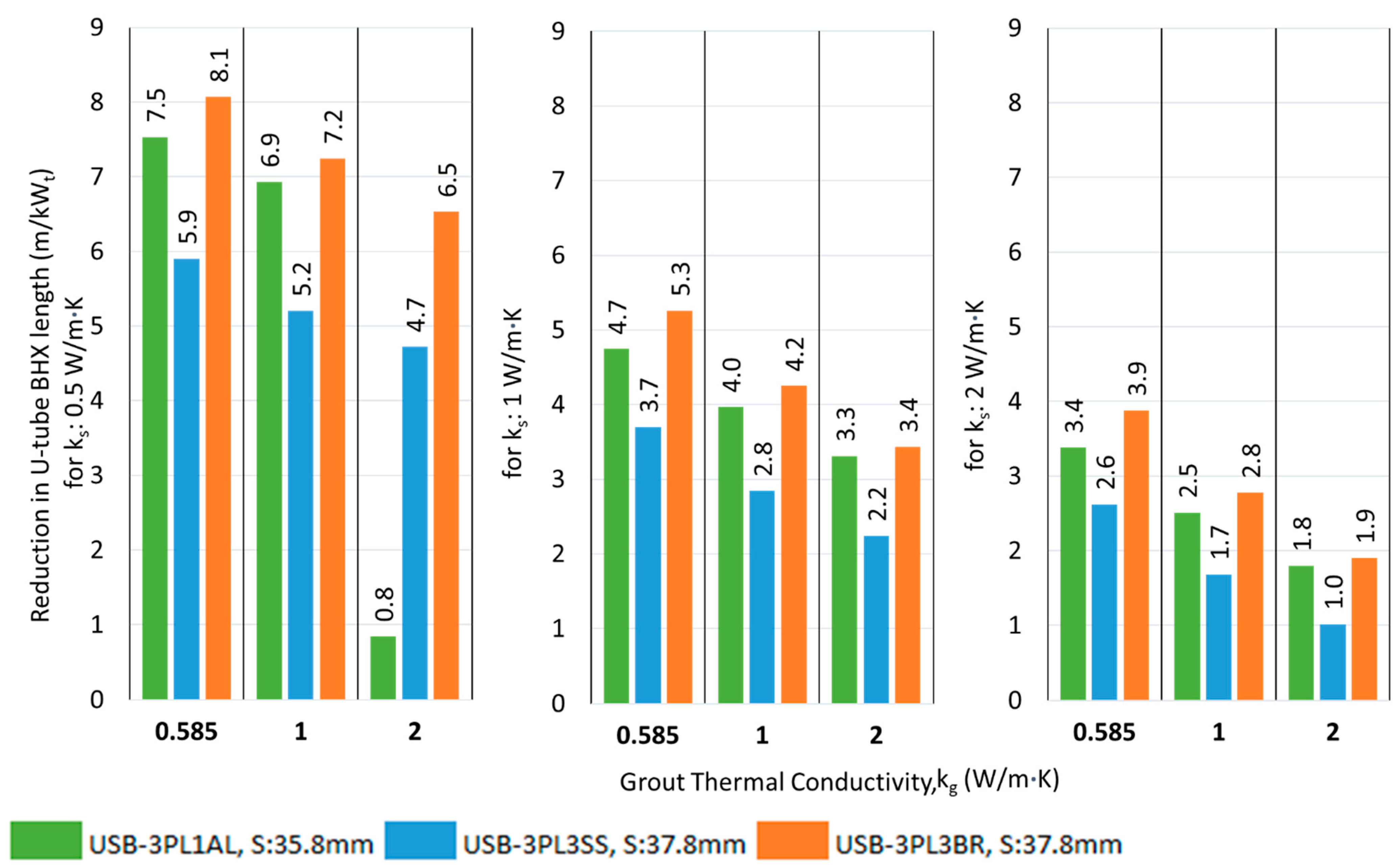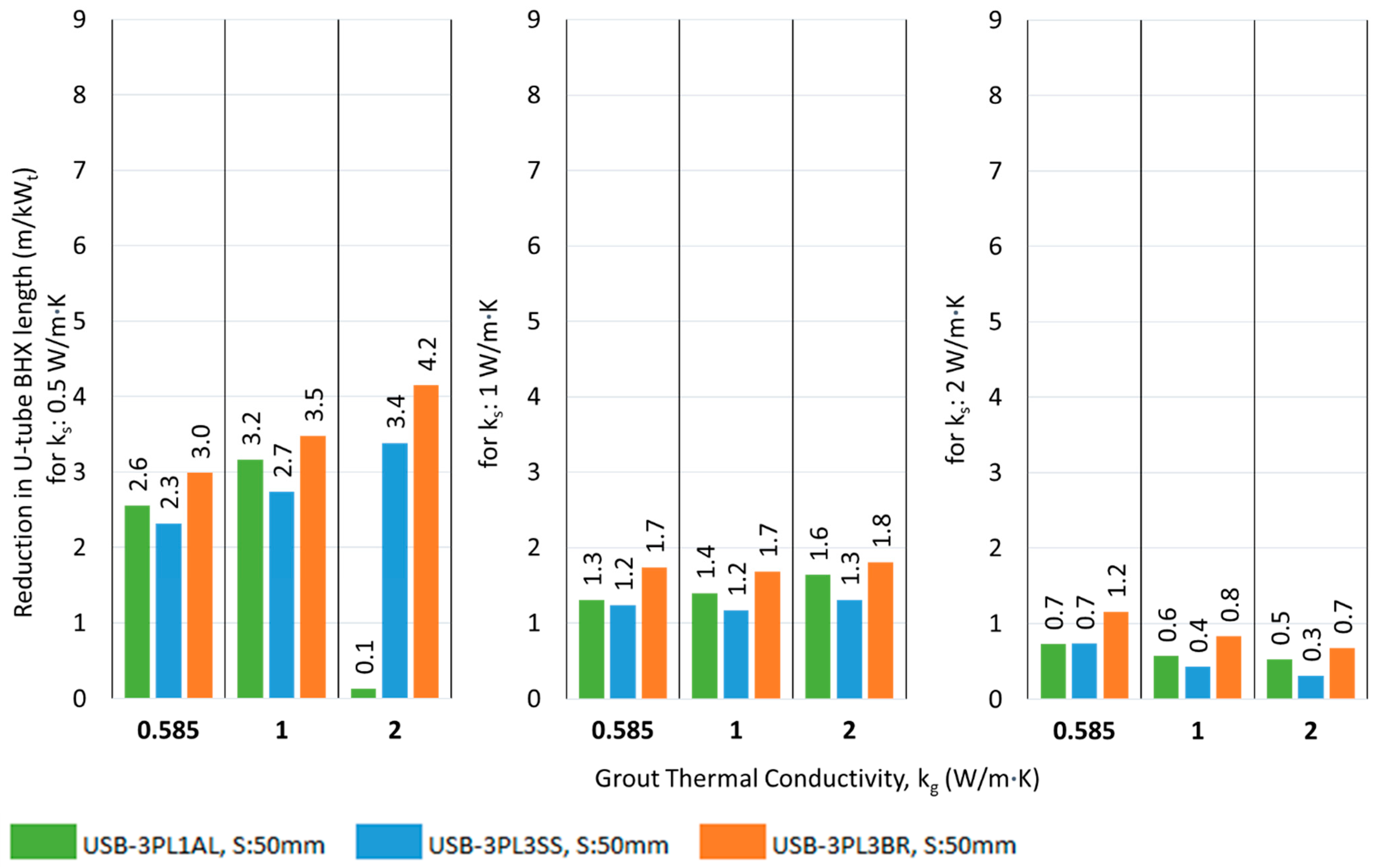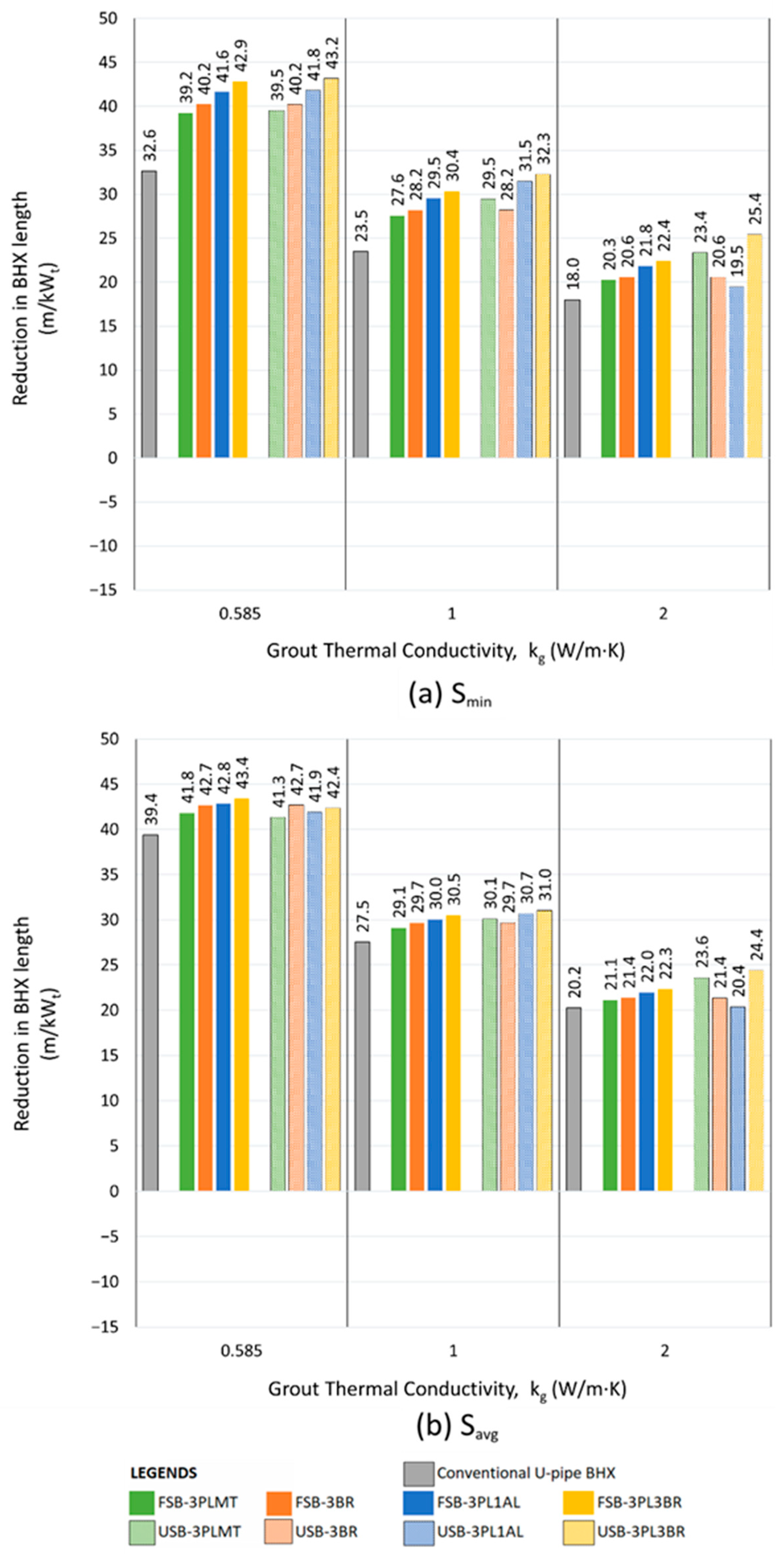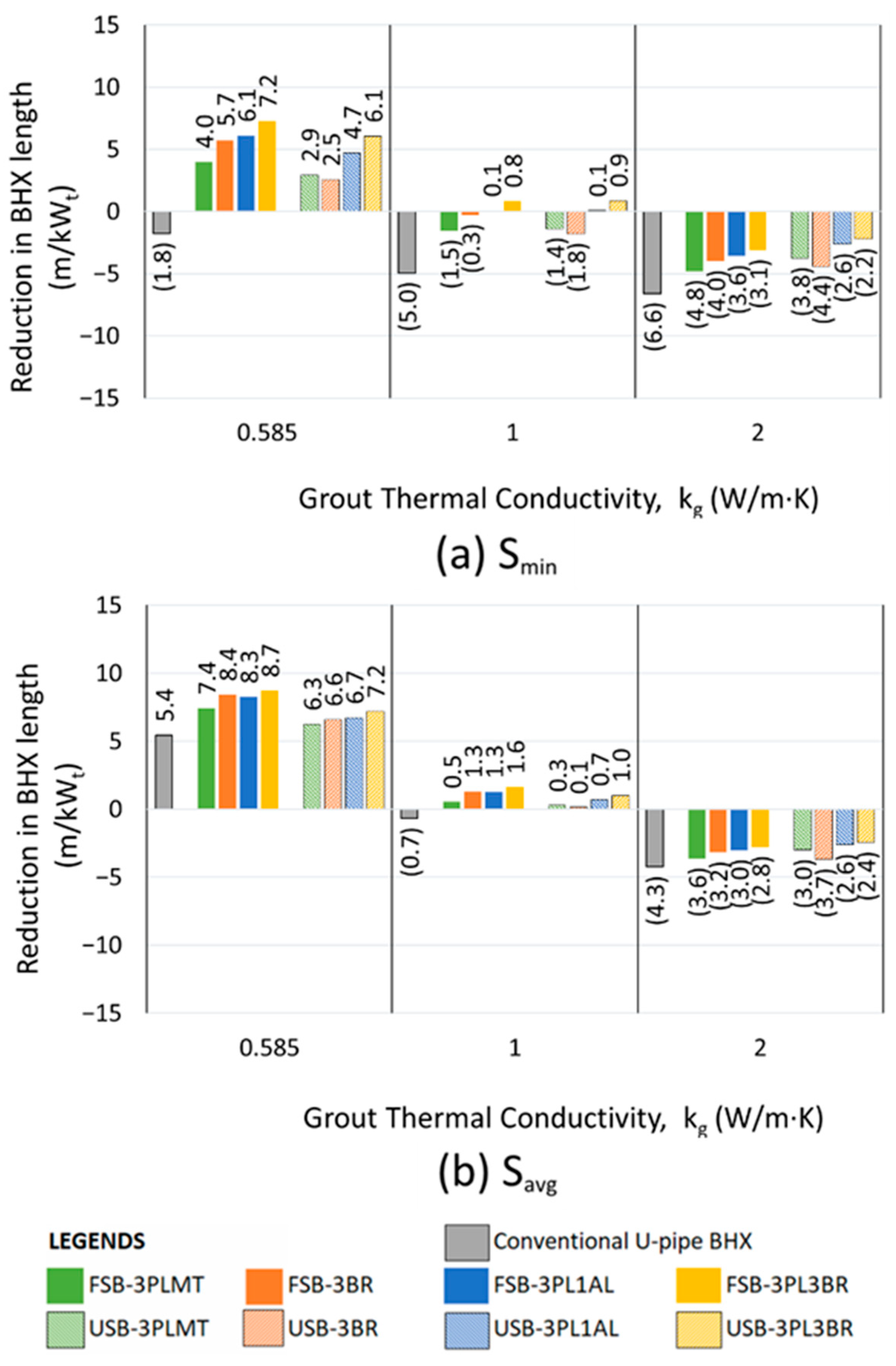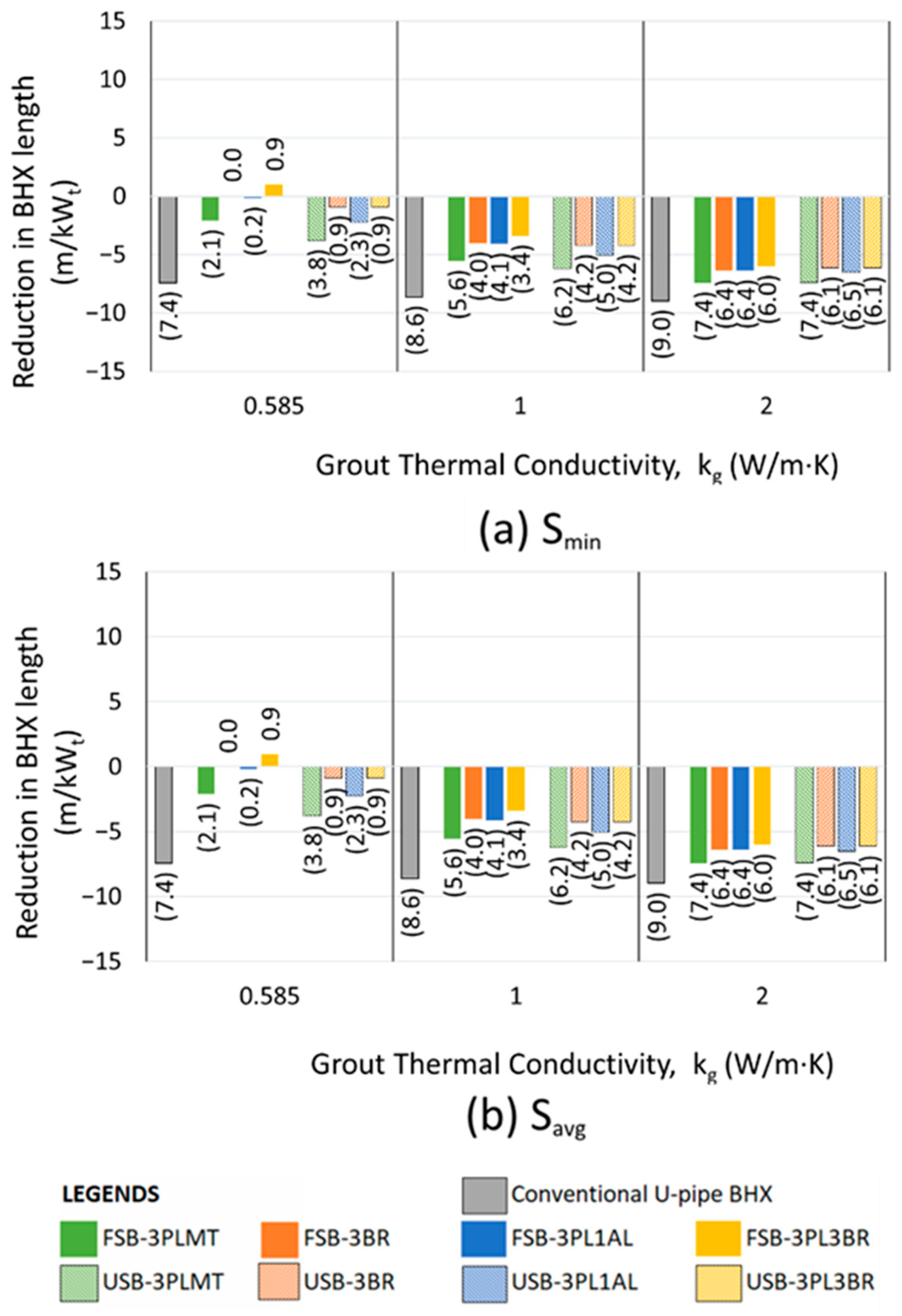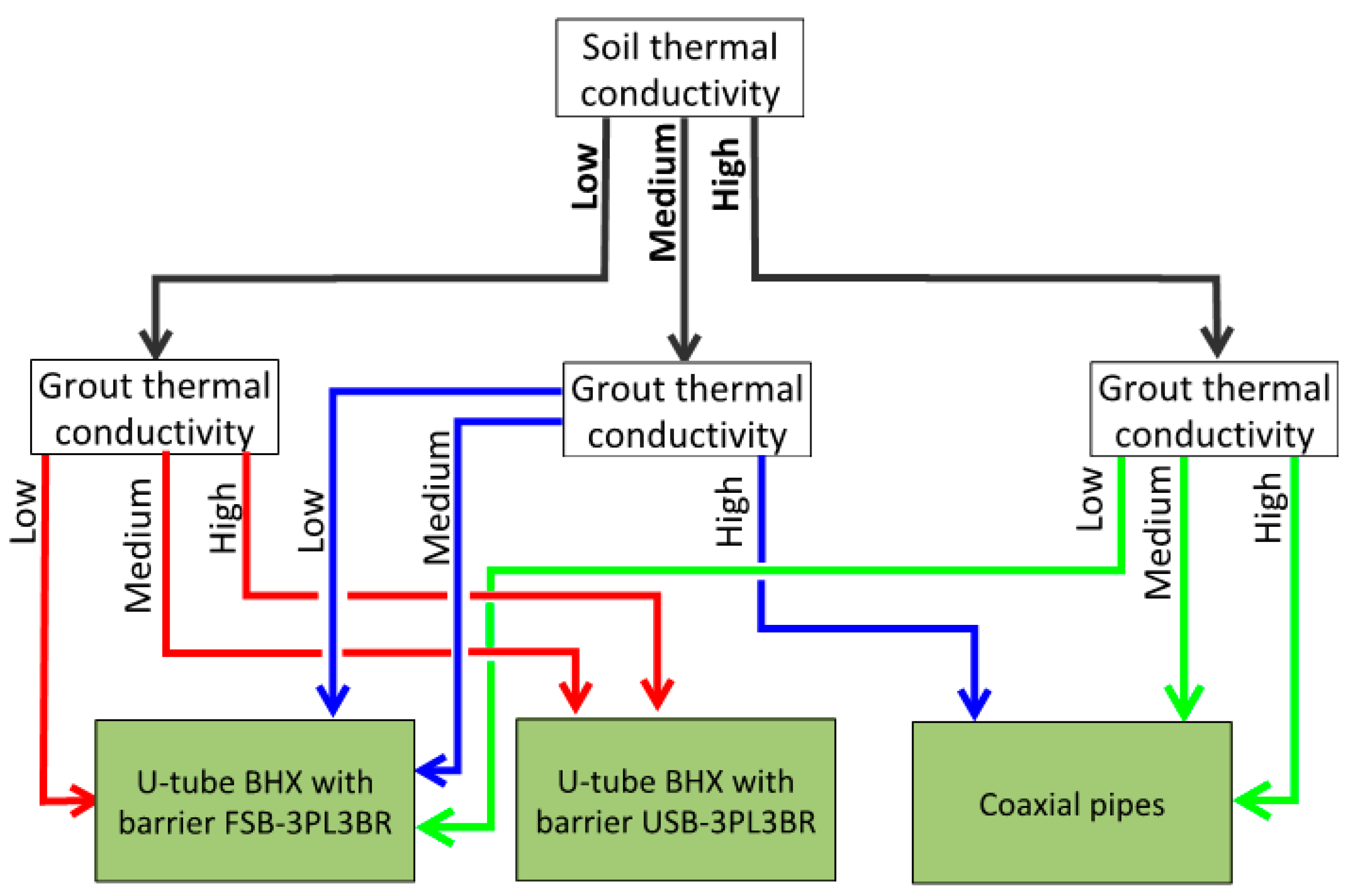1. Introduction
Closed loop vertical ground source heat pumps are notably widespread for their efficiency and effectiveness compared to other ground source heat pump types like horizontal closed loop, direct exchange, open loop, and surface water ground source heat pumps [
1]. One of their key advantages is the compact footprint of the heat exchanger in the form of a borehole, which makes them especially suitable for residential areas with small plots and commercial buildings [
1]. They also ensure stable ground temperature and demand minimal pumping energy [
1]. However, the system does have the drawback of requiring deep borehole drilling, which contributes to a higher cost and challenges related to expertise in borehole drilling and proper implementation [
1,
2].
Typically, water (or a mixture of water and antifreeze in below-freezing soil conditions) circulates on one side of the ground source heat exchange system, while refrigerant circulates on the other side, directly connected to the heat pump. According to ASHRAE-Applications [
3], U-tube boreholes typically range from 100 to 150 mm in diameter and have depths of 15–120 m. The U-tube borehole length can be further increased to 180 m or more if the procedures for deep boreholes are followed. A U-tube containing the circulating fluid is inserted into each borehole, typically made of polyethylene, with a diameter of 20–40 mm, although other pipe materials may also be utilized [
3].
Figure 1a,b illustrate the U-pipe arrangement.
An alternative to U-tube boreholes is a coaxial pipe arrangement where a smaller pipe (the inner pipe) is enclosed within a larger outer pipe. The heat transfer fluid can be circulated in two ways. One way is to enter the fluid through the outer pipe (inlet pipe) and return the fluid via the inner pipe (outlet pipe). The other flow arrangement is to enter the fluid via the inner pipe (inlet pipe) and return the fluid via the outer pipe (outlet pipe).
Figure 1c,d illustrate the coaxial pipe arrangement with inflow through the annular pipe.
Usually, the space between the U-tube/coaxial pipe and the borehole wall is filled with grout, which serves a crucial role in stabilizing the U-tube/coaxial pipe within the buried system and preventing water seepage into the borehole. The BHX cost (which is mainly the cost of U-pipe, grout, and borehole drilling) for GSHP typically accounts for more than 30% of the total cost of the GSHP system [
4]. Given its significant expense, optimizing this component is vital for enhancing heat transfer efficiency and harnessing more sustainable energy from the same area of the land.
The total thermal resistance consists of two parts: the soil itself and the borehole as shown in
Figure 2. In a conventional U-tube BHX with geometrical symmetry of the inlet and outlet legs, the fluid temperature to be considered for the evaluation of borehole thermal resistance is the mean temperature of the inlet and outlet fluid temperatures [
5].
The borehole resistance component includes the resistance offered by grout, pipe material, and the circulating fluid. Contact thermal resistance is assumed to be negligible for simplification. The total thermal resistance is the sum of soil and borehole resistance.
A reduction in any of the above two components or both will lead to improved heat transfer. The heat transfer resistance characteristics of soil vary with geographic location and are generally immutable. Deep soil mixing offers a viable method to lower soil thermal resistance, yet its implementation is expensive and may not be economically feasible across all site conditions and soil types [
6]. On the other hand, there are methods to decrease R
b, i.e., BHX thermal resistance. Therefore, the overall thermal resistance of the system can be reduced for an enhanced heat transfer by adopting techniques to lower the BHX thermal resistance.
Increasing the length of the ground loop in a BHX reduces the approach of the BHX, defined as the difference between the average loop temperature T
f and the initial ground temperature T
s.
Reducing the thermal resistance between the ground and the circulating fluid enhances the heat transfer, thereby reducing the required length of the heat exchanger per kW for a given approach.
Previous research on the optimization of borehole thermal resistance has investigated the impact of pipe material, borehole diameter, shank spacing, and grout material. Research by Kerme et al. [
7] discusses various geometric factors (shank spacing, borehole size/diameter, borehole depth), grout, and soil thermal conductivity for single and double U-tube arrangements, and then proposes the combined effective measures for heat transfer improvement. Shen et al. [
8] discuss the various influential factors (such as flow rate, inlet temperature, heat extraction rate, length of BHX, and backfill material) on the performance of a deep U-tube BHX and suggest an optimal control of the flow rate.
According to Kavanaugh and Rafferty [
2], the choice of thermally enhanced grout material is also challenging. The grout filler must block surface water and unwanted groundwater from reaching aquifers, as they can pollute drinking or irrigation supplies. High solids sodium bentonite grout (>20% solids), while effective, is a poor heat conductor, whereas materials with good heat transfer may allow water migration. Some regulations may permit porous materials if the top 6 m of the borehole are sealed with nonporous grout. Cement-based sealants are ineffective for BHXs due to pipe shrinkage but can be enhanced with additives. The pouring of thermally enhanced grout with abrasive sand might also be challenging due to the unavailability of the pumping equipment with the installer.
Erol and François [
9] studied various BHE grout materials, including bentonite-based, silica sand-based, and homemade admixtures with graphite. Increasing graphite content beyond 5% or using all types of graphite powders in BHE backfill mixtures is impractical, as graphite’s varying properties can negatively affect grout flowability, permeability, and strength. Through a TRT test, they found that adding just 5% homemade natural flake graphite enhances grout thermal conductivity, crucial for optimizing heat transfer efficiency when matched appropriately to ground conductivity.
The study by Mahmoud et al. [
10] suggests that selecting the right grout depends on system conditions. Traditional grouts like bentonite and cement offer strength but require additives for better thermal performance. Phase-change material (PCM) is recommended for its storage capacity and stability. A mix of conventional grouts, additives, and PCMs is recommended for optimal results.
Liu et al. [
11] conducted a comprehensive study to assess potential cost reductions through enhancements in borehole heat transfer under diverse geological and thermal conditions and revealed that improvements such as enhanced grout and double U-tube loops effectively reduce borehole lengths. This study primarily focuses on installation costs and relies on the simplified geometrical approach of Eskilson’s g-function through commercial software GLHEPro.
Studies have also been conducted on the comparison of a U-tube with coaxial pipes and a few other arrangements like double U-tube, discussing the thermal behavior of the BHX with these arrangements. A study conducted by Zanchini et al. [
12] showed that in coaxial pipes, the configuration where water flows into the BHX through the outer annular pipe and exits through the inner pipe provides superior thermal performance compared to the opposite arrangement, where inflow occurs through the center or inner pipe and outflow through the outer annular portion. Brown et al. [
13] modeled coaxial, single U-pipe, and double U-pipe configurations, finding that coaxial pipes exhibit the highest heat transfer rate and a lower pressure drop. Harris et al. [
14] demonstrated that the coaxial BHX configuration is more effective than the double U-pipe design. According to Chen et al. [
15], by using double U-tubes in parallel in BHXs, the heat transfer capacity may increase by over 50% from the single U-tube system, which could justify the cost increase in installation and pumping energy consumption. Chen and Tomac [
16] suggest the use of a VIT (Vacuum Insulated Tube) for coaxial pipe arrangement to prevent thermal short-circuiting. An economic analysis is suggested, as the cost of VIT could be substantially higher than the cost of uninsulated tubing.
While there is ample research available on the comparative study of the materials and geometry of the U-tube BHX and its comparison with other arrangements like coaxial pipes and double U-tube, there is not much research on segregating the inlet and outlet leg of the U-tube to prevent direct interaction with each other.
Al-Chalabi [
6] investigated the effects of introducing I-shape and U-shape obstructions in a U-tube BHX. However, this study did not account for the thickness of the U-tubes, which led to extremely an overestimated efficiency of the barriers compared to scenarios where tube thickness is considered. In addition, this study is limited to the highly thermally conductive grout with a ratio k
g/k
s of 2 and does not provide an insight into the various alternatives of the grout and soil. The results are reported in terms of the borehole thermal resistance instead of an overall thermal resistance. High thermal conductivity grout results in a lower contribution of the BHX thermal resistance out of the total thermal resistance of the soil and BHX. Therefore, there is a need to report the net impact of the saving in terms of an overall reduction in the total thermal resistance or borehole length or an overall increase in the heat transfer.
Ngo and Ngo [
17] conducted a numerical assessment to evaluate the impact of an insulated, flat shape barrier between the U-tube legs of the ground heat exchanger. This study examines the effects of the Reynolds number on heat transfer, focusing on laminar flow with a low Reynolds number value (optimal heat transfer at a Reynolds number of 120 and suggests that at lower Reynolds number values, heat transfer increases due to a decrease in the outlet temperature (T
fo) for a given inlet temperature (T
fi), though it does not address the impact of a reduced mass flow rate on the heat transfer as a result of a lower Reynolds number value. The heat rejected by the fluid for cooling will be as follows [
2]:
The expression for Reynolds number is as follows [
18].
The above equation depicts that the mass flow rate of the fluid is a function of the Reynolds number. Under the given geometry and fluid temperature, the Reynolds number varies directly proportional to the mass flow rate of the fluid, which means the higher the mass flow rate, the higher the Reynolds number for a given geometry and fluid temperature. In the case of turbulent flow through pipes, the Reynolds number is ≥10,000 [
18]. Ngo’s study, with a Reynolds number of 120, will have a significantly lower flow rate with the same geometry compared to the flow conditions considered in other studies with a turbulent flow. This study does not very clearly state the pipe material considered; however, it mentions that their study reports high-efficiency operation with 16% enhanced heat transfer when a copper pipe is used instead of high-density polyethylene. It is therefore understood that they have conducted a study based on copper pipes. Previous studies suggest that the use of HDPE pipes is very common due to better performance, durability, and economics [
2,
19,
20,
21]. The assumption of copper piping with laminar flow within the U-tube could increase the risk of thermal short-circuiting than with a high-density polyethylene pipe [
2]. Due to more short-circuiting, the results of improved heat transfer due to the barrier between the inlet and outlet pipe will be misleading. The thickness of the pipe is also neglected, which will overestimate the performance of the barrier. Because this study is not based on optimal parameters, there is a potential to increase heat transfer further by improving the flow rate and pipe material. Measures to improve these parameters will result in a change in the reported impact of the barriers in this study, which warrants further analysis to draw definitive conclusions.
Previous studies about grout material have suggested that grout selection for better thermal conductivity might be challenging and may be compromised for the strength of the BHX and/or economy. A novel technique with barriers between the two legs of a BHX to optimize heat transfer should be explored as an alternative to the conventional way of increasing the heat transfer by thermally enhanced grout. This technique can also be applied in addition to the conventional methods to further increase the heat transfer. There is a need for a detailed evaluation of the thermal performance of the barrier between the two legs of a U-tube BHX, with a specific comparison to a conventional U-tube system. Due to the complexity of the BHX geometry, a numerical assessment would be more appropriate. Flat plate and U-shape geometries of the barrier are studied with various materials and thicknesses. The design parameters of the BHX geometry and flow are optimized before evaluating the effect of the barrier. A comparison is made with a focus on depicting the sole contribution of the barrier from the base case. It is also required to report the results of the overall impact in terms of the net increase in heat transfer or the net reduction in the BHX length. This will allow for a clearer assessment of the barrier’s unique contribution in optimizing the BHX length and help implement the barrier technique, which contributes to the enhancement of heat transfer through the BHX. Additionally, it would be beneficial to compare the results of numerical assessment for barrier techniques with other heat transfer enhancement techniques, such as coaxial pipe arrangements, to offer a broader selection of borehole heat exchanger (BHX) design options.
4. Discussion
4.1. Comparison of This Study with the Previous Studies
The barrier analysis conducted by Al-Chalabi [
6] was based on a k
g/k
s value of 2 with a d
b/d
p value of 3.33. The ratio d
b/d
p in our analysis was 3.15; which is considered to be approximately equal to the value in the study by Al-Chalabi [
6] for comparison. The far-field radius was 1 m in both studies. The values of the thermal conductivities of the barrier materials and their geometry were identical. The previous study mentioned the results corresponding to the ratio k
g/k
s, which has a value of 2 in the previous study. In this study, k
g/k
s value of 2 will be equivalent to the following two scenarios:
A comparative summary of the results of the analysis by Al-Chalabi [
6] and the relevant results in our analysis are depicted in
Table 15.
The previous study presents the results in terms of the ratio kg/ks which was set as 2; however, as per this study, the results of the heat transfer rate and borehole thermal resistance for two scenarios with an identical kg/ks ratio but different values of kg and ks revealed a different value for borehole thermal resistance.
The values of borehole thermal resistance between this and the previous study do not match with the lower values in the previous study. This is because of not considering the thickness of the HDPE pipe in the analysis and therefore the resistance of the pipe material was not added to the BHX thermal resistance. In addition, it is noted in this study that increasing the soil thermal conductivity decreases the borehole thermal resistance for the same kg/ks ratio, so the difference in values in the two studies might also be due to the use of non-similar conditions of ks and kg.
In this study, the barrier technique is found to be more effective in decreasing the BHX resistance for a lower kg/ks ratio. The previous study is based on a higher value of kg/ks and therefore lacks an analysis of the scenarios where the barrier technique may perform more effectively.
The previous study discusses only the percentage reduction in the thermal resistance of the borehole and does not provide an overview of the goal of improving the heat transfer rate or reducing the BHX length. The percentage of borehole thermal resistance in the total resistance of a ground heat exchange system varies with changes in grout thermal conductivity and is higher for lower thermal conductivity grouts and gradually decreases with an increase in the grout thermal conductivity. Therefore, the indication of a percentage reduction in the thermal resistance of the borehole will not warrant the effectiveness of the barrier design, which offers a higher percentage reduction in borehole thermal resistance. Instead, the indication of the net heat transfer rate or BHX length reduction may provide a better understanding.
This study fills the gap in the previous study by providing a comprehensive study discussing various combinations of soil and grout thermal conductivity with a conclusive indication of heat transfer rates and BHX length reduction.
4.2. Comparision of Different Barriers with Conventional U-Tube
The impact of a barrier between the U-tube legs of a BHX in reducing the length is better for closer shank spacing than average shank spacing. For example, the saving in U-tube BHX length decreases from 6.4 to 3.3 m/kW
t in the case of FSB-3BR with k
s of 0.5 W/m·K and k
g of 0.585 W/m·K when the shank spacing increases from 34.8 mm to 50 mm (refer to
Figure 17 and
Figure 18). For average shank spacing of 50 mm, the maximum reduction in the absolute length of the BHX due to barrier arrangement was 4 m/kW
t for the flat plate barrier when the FSB-3PL3BR double flat plate barrier was introduced for S
avg, k
s of 0.5 W/m·K and k
g of 0.585 W/m·K. For the U-shape barrier, the maximum reduction was 4.2 W/m·K when the USB-3PL3BR double flat plate barrier was introduced for S
avg, k
s of 0.5 W/m·K and k
g of 2 W/m·K.
The absolute reduction in length was found to be higher for lower thermal conductivity grout, except for the case of double U-barriers with average shank spacing, where the absolute reduction for higher thermal conductivity grout was found to be higher.
The performance of flat plate-shaped barriers did not show a significant variation across different soil thermal conductivities when the grout thermal conductivity remained constant. However, this difference becomes quite pronounced for U-shaped barriers. For example, the reduction in BHX length for the case of FSB-3BR at Smin and kg of 0.585 W/m·K is 6.4, 6.2, and 6.1 m/kWt for a soil thermal conductivity of 0.5, 1, and 2 W/m·K, respectively; whereas, for the case of USB-3BR at Smin and kg of 0.585 W/m·K, the reduction was 6.4, 3.0, and 2.7 m/kWt for a soil thermal conductivity of 0.5, 1, and 2 W/m·K, respectively.
The performance of the double U-barrier USB-3PL3BR was found to be the best out of various single and double U-shaped barriers. The same trend was noted for flat shape barriers, where FSB-3PL3BR was also the best in thermal performance.
The performance of flat plate barrier arrangement FSB-3PLMT was found to be better than FSB-3SS for almost all scenarios of shank spacing, ks,, and kg; the same trend was observed for the U-shape barrier, where USB-3PLMT also outperformed USB-3SS.
The absolute reduction in length achieved by using a double flat plate barrier was not twice that of the single metallic barrier under the same operating conditions but instead showed a slight increase. For instance, with ks of 0.5 W/m·K and kg of 0.585 W/m·K, the BHX length reduction was improved from 6.4 m/kWt to 7.8 m/kWt, representing a further reduction of 1.4 m/kWt (or 22%) between the FSB-3BR and FSB-3PL3BR. This trend was even less pronounced at higher soil thermal conductivities of 1 and 2 W/m·K. For U-shaped barriers, the trend showed a marginal improvement over flat plate barriers.
4.3. Overall Comparison of Different Ground Heat Exchange Systems Discussed in This Study
The design of the insulated outlet leg of the U-tube BHX was found to be ineffective in improving the heat transfer rate of the BHX. The design of the coaxial pipe arrangement showed that the arrangement was suitable for improving the heat transfer for medium and high thermal conductivity soil of 1 and 2 W/m·K. For soil with a low thermal conductivity of 0.5 W/m·K, the significant short-circuit losses in coaxial pipes make the conventional U-tube a more favorable option compared to coaxial pipes.
Figure 25,
Figure 26 and
Figure 27 show the absolute reduction in the BHX length compared to the coaxial pipe arrangement for k
s of 0.5, 1, and 2 W/m·K, respectively. The figures show the length reduction for the conventional U-tube BHX and different scenarios of the U-tube BHX with single and double barriers. The performance of the stainless steel barrier options (FSB-3SS and USB-3SS) was found to be comparable to or lower than that of the FSB-3PLMT and USB-3PLMT options in most scenarios. As a result, for simplicity, the single stainless steel barrier options were omitted from these figures. Similarly, the performance of FSB-3PL3SS and USB-3PL3SS were found to be worse than FSB-3PL1AL and USB-3PL1AL and therefore omitted.
The minimum shank spacing (S
min) for the various U-tube BHX configurations shown in
Figure 25,
Figure 26 and
Figure 27 varies depending on the geometry. It is 31.8 mm for the conventional U-tube BHX, 34.8 mm for FSB-3BR and USB-3BR, 35 mm for FSB-3PLMT and USB-3PLMT, 35.8 mm for FSB-3PL1AL and USB-3PL1AL, and 37.8 mm for FSB-3PL3BR and USB-3PL3BR. The average shank spacing is 50 mm across all options.
In
Figure 25,
Figure 26 and
Figure 27, for the configurations where the performance of the conventional U-tube BHX (without a barrier) is superior to the coaxial pipe arrangement, the contribution of the barrier to reducing the BHX length is the difference in length reduction between the conventional U-tube and the barrier-equipped option. For example, in
Figure 25, with k
s and k
g values of 0.5 and 0.585 W/m·K at S
avg, replacing coaxial pipes with a conventional U-tube BHX reduces the length from 191.4 m/kW
t (for coaxial pipes) to 158.8 m/kW
t (for the conventional U-tube). Adding the USB-3PL3BR barrier to the U-tube BHX further reduces the length to 148.2 m/kW
t.
The best-performing barriers were the double barriers made of 3 mm plastic and 3 mm brass, both in flat plate and U-shape configurations. The flat plate barrier FSB-3PL3BR outperformed the U-shape barrier USB-3PL3BR in reducing the BHX length for a k
g value of 0.585 W/m·K. However, the USB-3PL3BR demonstrated better performance than the FSB-3PL3BR for a k
g value of 2 W/m·K, as shown in
Figure 25,
Figure 26 and
Figure 27. The performance difference between FSB-3PL3BR and USB-3PL3BR was minimal for a k
g value of 1 W/m·K.
Based on
Figure 25,
Figure 26 and
Figure 27, we created the decision tree, as shown in
Figure 28, for the selection of the best ground heat exchange system to obtain an optimized length of the BHX. Soil with 0.5, 1, and 2 W/m·K is considered as low, medium, and high thermal conductivity soil, respectively. Grout thermal conductivity of 0.585, 1, and 2 W/m·K is considered low, medium, and high, respectively.
5. Conclusions
Vertical ground source heat pumps can be implemented as an economical option for heating/cooling, subject to them being carefully designed, especially for ground loop heat exchangers. Over-designing this component will lead to an uneconomical design, whereas under-designing will lead to discomfort. There is a need to adopt techniques to reduce borehole thermal resistance or, in other words, to improve the heat transfer process across the BHX.
Various barrier arrangements between the two legs of the U-tube BHX have been proposed, which provide a viable alternative to conventional U-tube arrangements and serve as a better option than coaxial pipes in certain conditions of soil and grout thermal conductivity.
The double barrier arrangement, FSB-3PL3BR and USB-3PL3BR, has shown the best performance compared to a conventional U-tube BHX, with a possible reduction of 7.8 and 8.1 m in the length of the BHX per kW of heat transfer, respectively, for ks of 0.5 W/m·K and kg of 0.585 W/m·K. The other simple option of a 3 mm plastic barrier with 0.2 mm metallic tape, i.e., barrier arrangements FSB-3PLMT and USB-3PLMT, though offering comparatively lower heat transfer improvements, may still perform economically, especially in settings where installation simplicity and cost-effectiveness are prioritized. A reduction of 7.3 and 7.5 m in the length of the BHX per kW of heat transfer is possible from FSB-3PLMT and USB-3PLMT for ks of 0.5 W/m·K and kg of 0.585 W/m·K.
This study demonstrates that the novel design of barriers with various geometries and materials between the two legs of a U-tube BHX presents viable alternatives to conventional U-tube arrangements in ground heat exchanger systems and shows better performance over coaxial pipes for low to medium thermal conductivity soil and grout. Although flat and U-shape barriers with 3 mm plastic and 3 mm brass were the best options for length reduction, the other options discussed in this study, which showed an improvement in the heat transfer, may also be considered based on simplicity in construction or lower cost. A cost–benefit analysis is recommended for the selection of the type of BHX arrangement among the various options discussed for a given soil condition, especially where the difference between various options is marginal.
The barrier techniques in this study are limited to two-dimensional steady-state analysis. Further numerical study with a three-dimensional analysis may precisely determine the resulting reduction in the BHX length. Dynamic modeling may also help in the precise determination of the overall improvement in heat transfer for the long term. A minimum overall barrier thickness of 3 mm has been considered to ensure the strength and stability of the barrier for deep burial in the vertical borehole. Structure analysis of the precise thickness of the barrier may be undertaken for further optimization. This study can be continued for double U-pipe arrangements and other configurations.
